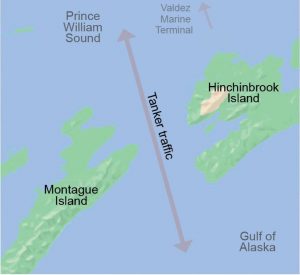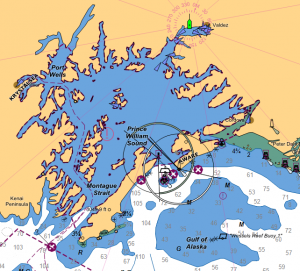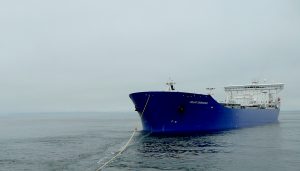Science Night returned this year, better than ever! This annual event, hosted by the Prince William Regional Citizens Advisory Council, focuses on research related to the safe transportation of oil through Prince William Sound.
Maritime Operations
Study shows purpose-driven design can improve performance
When a ship is disabled at sea, an appropriate rescue vessel must respond quickly to prevent an accident. Towing can be dangerous, especially in rough weather, because the rescue tug must get close to connect a towline.
Challenging environment in Alaska

Hinchinbrook Entrance is a narrow waterway that connects Prince William Sound to the Gulf of Alaska. The weather and sailing conditions in the gulf can change rapidly and are often severe.
Tankers carrying millions of gallons of oil regularly pass through the Entrance. Alyeska’s Ship Escort/Response Vessel System must have a tug stationed at the Entrance when laden tankers travel through Prince William Sound.
Repairs to Prince William Sound’s radar in the works

Coast Guard planning long-term project to replace entire system
Radar that helps the U.S. Coast Guard monitor vessels in Port Valdez is undergoing repairs.
This radar is part of the Coast Guard’s Vessel Traffic Service, or VTS, which monitors and manages vessel traffic movements in busy waterways such as Prince William Sound. Three radar sites across Prince William Sound relay information to Valdez, where the data is integrated with other technologies onto an electronic display.
All three sites have struggled to stay online recently because of the harsh Alaska environment coupled with normal wear and tear. The Coast Guard plans to have at least one radar at each of the three sites operational by September 2021.
Planning for further upgrades
U.S. Coast Guard Commander Patrick Drayer joined a Council meeting in January to report that the Coast Guard’s long-term plan is to develop plans to upgrade all of the VTS radar systems nationwide. The Coast Guard will begin an in-depth review starting this summer to help plan these upgrades. The timeline and cost for replacement is not yet known as it is still early in the planning process.
Meanwhile, the Coast Guard is monitoring the Sound using other technologies. While other technologies serve valuable roles, the Council does not believe that other technologies can adequately replace the surveillance and collision avoidance capabilities that modern radar provides.
The Council is planning a review to better understand how these technologies work together to prevent accidents and potential oil spills.
Escort tug Courageous damages the tanker Polar Endeavour in January incident

Just before midnight on January 11, the escort tug Courageous allided with the tanker Polar Endeavour, which had just finished loading crude oil at Berth 4 at the Valdez Marine Terminal.
An “allision” occurs when a moving vessel comes in contact with a stationary object or vessel.
A “collision” occurs when both objects or vessels are moving when contact occurred.
The Courageous is owned and operated by Edison Chouest Offshore, the contractor who provides spill prevention and response services for Alyeska.
The tug was approaching the fully loaded tanker to assist the tanker as it prepared for departure. The tug struck the hull of the Endeavour, damaging a ballast water tank. Some of that ballast water was released into Port Valdez. The Endeavour carries crude oil in cargo tanks that are separate from the ballast water tanks, so there was no oil in the damaged tank and none was spilled.
ConocoPhillips, the company that owns the Endeavour, made temporary repairs onsite. The U.S. Coast Guard inspected the tanker and approved it to sail to Long Beach, California, for permanent repairs.
One mariner aboard the Courageous received minor injuries and is expected to fully recover.
The U.S. Coast Guard is still conducting its investigation, however initial reports indicate it appears that the incident was caused by human error.
At the January meeting of the Council’s Board of Directors, Alyeska noted several remedial actions, including restricting the use of autopilot in certain areas and clarifying standing orders.
The Council is tracking this incident and the subsequent changes and will provide advice on how to prevent a similar incident in the future.